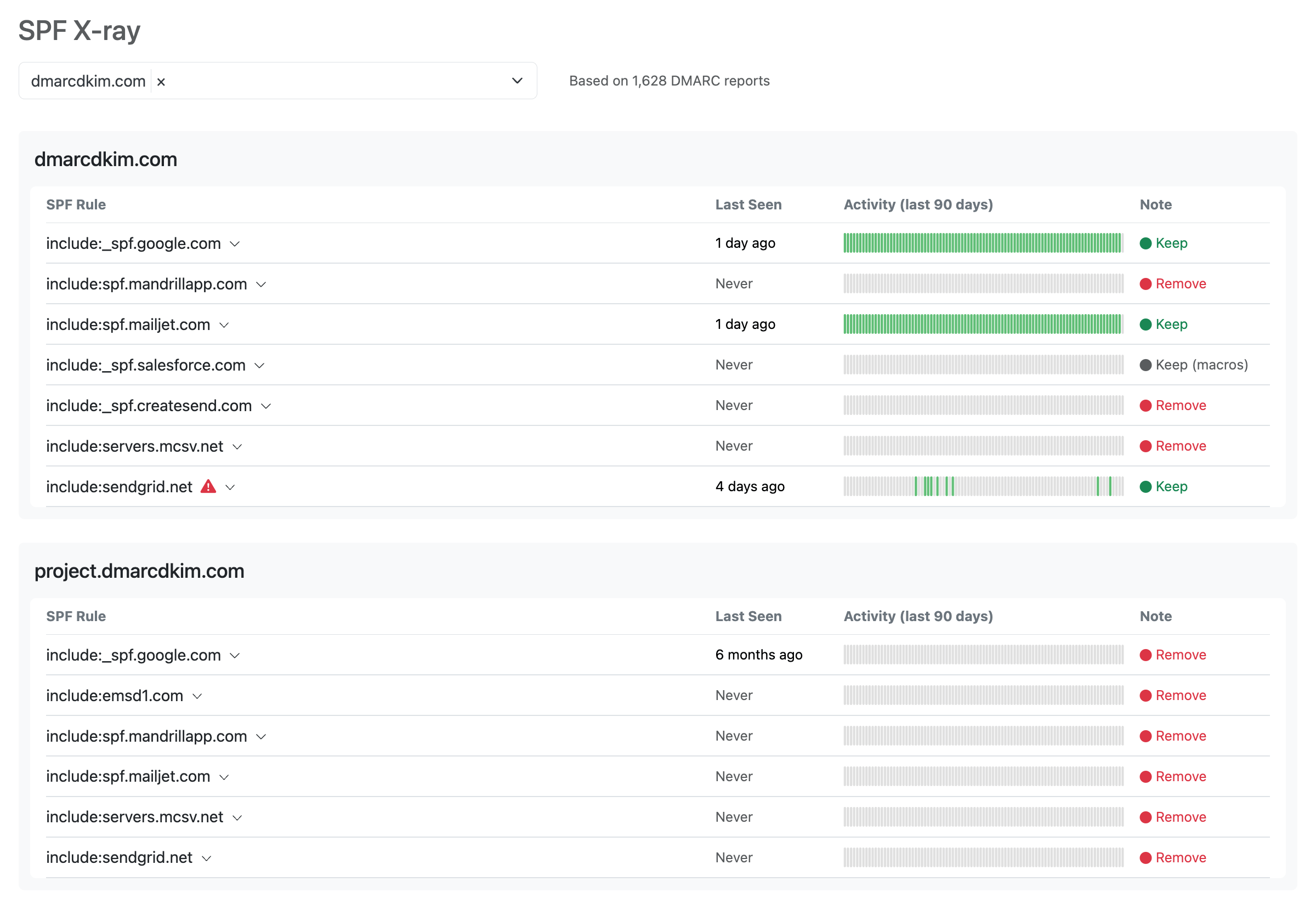SPF X-ray
Get instant visibility into every SPF record — find errors, duplicates, and outdated entries in seconds. Comply with DMARC alignment and fix the 10 DNS lookup limit.
Analyze SPF RecordThe Real Impact for You
SPF X-ray isn't just diagnostics — it protects your brand reputation, keeps mail flowing, and gives your ops team back control and time.
Deliverability You Can Trust
More of your legitimate mail lands in your customers inbox, no hidden SPF breakages.
Time Back to Your Team
Stop firefighting SPF issues. Get instant actionables backed by data.
Continuous Compliance
DMARC-linked monitoring keeps your SPF clean, compliant, and auditable.
Built for Change
Providers update IPs, you stay stable. No flattening. No outages.

Deep SPF Analysis
Comprehensive SPF record analysis that goes beyond basic checks
Identify issues, redundancies, and optimization opportunities
All SPF records in one view
include:
chains, and detect syntax errors, duplicates, invalid mechanisms, and risky flattening.
SPF X-ray reviews your entire SPF configuration, scanning DNS across subdomains and mapping actual sender usage from DMARC reports. Get actionable guidance to optimize your records, merge multiple entries into a single valid SPF record and flag deprecated mechanisms with recommended replacements.
- Syntax validation and multiple-record detection
- SPF records lookup optimization (≤10 limit)
- Deprecated mechanism review and cleanup
After changes are live, SPF X-ray continues monitoring via DMARC reports, highlighting unused SPF entries after 90 days so you can safely remove them.
We correlate DMARC aggregate reports with your SPF rules. If a referenced SPF record (or include) isn't observed in traffic for 90 days, we mark it as unused and recommend removal.
Result: a lean, auditable SPF that stays fast, accurate, and easy to manage — without SPF flattening.
Sign up with your domain to collect DMARC reports and x-ray your SPF record.
Get first results on your SPF record performance & optimize your setup
Use our monitoring and we tell you which records are not in use and can be safely removed
Why SPF Flattening Is Outdated in 2025
SPF flattening used to be a tricky workaround for 10 DNS lookup limit, but with DMARC SPF alignment, email protection is now simpler, more reliable, and easier to maintain.
Breaks easily
Flattened records fail when providers change their IPs.
Vendor lock-in risks
Third-party vendors control your SPF records, limiting ownership and flexibility.
Modern best practice
Assign each provider its own SPF record on a subdomain — keeping your root domain clean, stable, and scalable.
Bottom line: SPF flattening cleans the surface — but only subdomain segmentation future-proofs your email authentication.
SPF Questions & Answers
An SPF (Sender Policy Framework) record is a DNS entry that defines which mail servers are allowed to send emails for your domain. It helps prevent email spoofing and phishing by allowing receiving servers to verify that messages come from an authorized source. Without a valid SPF setup, your legitimate emails may end up in spam or fail delivery.
SPF verification fails automatically if your record triggers more than 10 DNS lookups — a common cause of email delivery issues. SPF X-ray detects excessive includes, loops, or redirects and helps reorganize your configuration into optimized, subdomain-based SPF records that stay compliant and reliable.
SPF flattening was once used to reduce DNS lookups by replacing includes with IP addresses, but it's now considered brittle and hard to maintain. When providers change their IP ranges, flattened SPF records break silently, harming email deliverability. SPF X-ray replaces flattening with a modern, subdomain-based SPF design that's reliable and automatically updatable.
SPF X-ray integrates directly with DMARC reports to link SPF performance with real sender activity. It detects unused or obsolete SPF records, checks domain alignment with DMARC policies, and recommends cleanups when entries haven't been used for over 90 days — ensuring long-term deliverability and compliance.
You should review your SPF configuration whenever you add, remove, or change a sending provider such as Google Workspace, Microsoft 365, or SendGrid. SPF X-ray continuously monitors your DNS and DMARC data, alerting you to configuration changes to keep your email authentication (SPF, DKIM, DMARC) accurate and secure.
Check your DMARC Setup
SPF is an integral part of the DMARC framework which ensures that no one can send emails in your name and your emails reach your customers inbox
